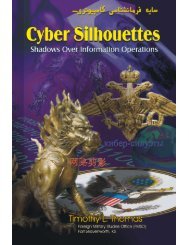Uyghurs Without Borders? - Foreign Military Studies Office - U.S. Army
Uyghurs Without Borders? - Foreign Military Studies Office - U.S. Army
Uyghurs Without Borders? - Foreign Military Studies Office - U.S. Army
You also want an ePaper? Increase the reach of your titles
YUMPU automatically turns print PDFs into web optimized ePapers that Google loves.
Russian interests in the Xinjiang region have been political and economic. Russia hastraditionally created buffer zones around its territory in an effort to protect itself and to createeconomic opportunities. These regions became absorbed into the Russian Empire (and laterSoviet Union), as was the case for the Central Asian states, or became focus points of Russianeconomic interest as in the case of Xinjiang. As early as the eighteenth century, Russia importedgoods from areas in Xinjiang. 6During this time the border between the Russian Empire and theChinese Qing Dynasty was open, which allowed <strong>Uyghurs</strong> to come over from Xinjiang and trade.From the mid-eighteenth century up to the 1950s, Russia conducted a large amount of trade withXinjiang, as it had not yet been fully integrated into China proper. 7For several decades <strong>Uyghurs</strong>conducted cross-border trade, which meant that they often lived in the Russian Empire. 8However, certain political events solidified how <strong>Uyghurs</strong> came to Kazakhstan.In 1864 Muslims in Xinjiang, as well as other regions across China, revolted against theQing Dynasty. Russia helped suppress the revolt by moving into the Ili region of Xinjiang in1871. Russia occupied this area until 1881 when it signed the Treaty of St. Petersburg withChina. One of the terms of this treaty allowed <strong>Uyghurs</strong> from this region of Xinjiang to migrateto the Russian Empire (Kazakhstan). A large number of them left Xinjiang at this time andcross-border trade continued, although some <strong>Uyghurs</strong> fled the Soviet Union to Xinjiang duringpurges in the 1930s. Conversely, in the 1950s and 60s there were events in China that againcaused <strong>Uyghurs</strong> to flee and settle in the Soviet Union.9When Soviet-Chinese relations turnedworse, cross-border trade stopped until after Kazakhstan’s independence.The break-up of the Soviet Union once more enabled cross-border trade. Ethnic <strong>Uyghurs</strong>on both sides of the border began trading and came into contact with each other after many yearsapart.10 This contact highlighted the differences among <strong>Uyghurs</strong> that had been present for a few4
















